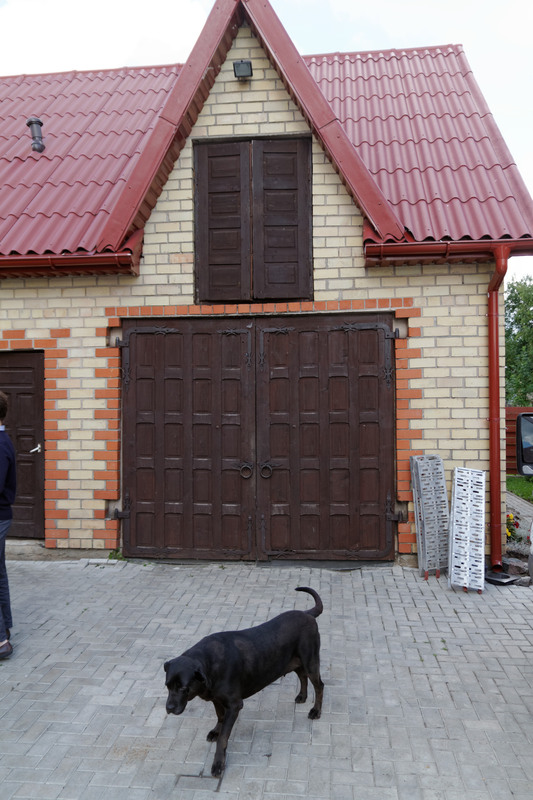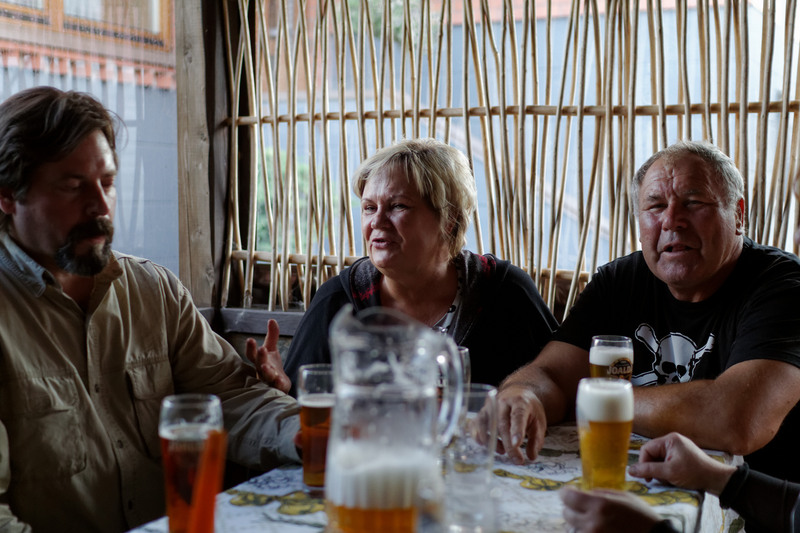Joalda, an artist in yeast

Brewery, with dog |
I've already told the story of how the "tasting" at Joalda went somewhat off the rails, but there's so much left to say I need another blog post. From the outside the brewery looks like a private dwelling, with a normal house, a little garden pavilion, and something like a combined barn and garage. That, of course, is the brewery. (This is part 5 of the Lithuanian brewery tour.)
We were greeted by an old, black dog, limping towards us, barking and growling, then retreating with a disgusted harrumph, before coming at us again. The others were sweet-talking her when the owner, Algimantas, showed up. He said she would never let anyone into the house before they had had a beer.
So of course he went and got a mug and glasses right away, pouring us a pale beer, which my notes say was called Joniškelio Respublika. It's named after a region of Lithuania that was liberated from both Germans and Russians by a local militia, called Joniškelio Mirties Bataljonas (Death Battalions of Joniškelis), during the confusion after the Russian Revolution. The t-shirt Algimantas is wearing in the picture below is emblazoned with their flag.
In the circumstances I couldn't do any proper notes on the beer, which I really regret now. There are hardly any ratings of their beers on Ratebeer, but the ones that are there are very good. That fits my memory, but I would have loved to have something more to back it up with.

In the brewery |
I still remember the mouthfeel of it, though. It started with a little splash of sweetness, fading into a silky smooth dusty straw and grain flavour. My notes mostly cover what Algimantas was saying, but occassionally there are comments like "Fantastically drinkable." or, a bit later, "Beer is crazily drinkable. Smoothness is unreal." It really was an amazing beer. And well in line with Algimantas's philosophy of beer, which he told us was that "a beer should be gentle, like a man with a woman, or a woman with a man."
Afterwards they served us an amber-coloured beer, which I think was the Karpiu Dvaro. Again, the whole event was such a crazy riot it was impossible to keep proper notes, and my memory is not totally reliable, either. The flavour escapes me, but the mouthfeel was the same. Interestingly, I had the same beer two days before, in Vilnius. It was really good there, but it was much better here. Clearly, this is not a beer that travels well.

Algimantas next to kettle |
Algimantas told us they started brewing illegally under the Soviets in 1980, at a time when private enterprise was frowned upon. They got their license in 1994, just after independence. The name actually stands for Joniškelios Alaus Darykla, that is, Joniškelios Brewery. He says he started out with wooden equipment, then gradually modernized into the all-steel setup they have now. Indeed, it looks pretty modern, with a bottling machine and everything.
He says they use Lithuanian malts and French yeast. I should have asked about the hops, but the tour was so lively it was hard to get a word in, and anyway I was taking pictures, making notes, and carrying my beer at the same time.
He top-ferments the beer, using very fresh, vigorous yeast. He shows us how the lid of the fermenter lifts, to blow off excess pressure. Then, after three days, he says, the beer is pumped into tanks in another room, where it cold-ferments. So, in fact, he actually both top- and bottom-ferments the beer. These truly are hybrid beers. Maybe that's how he achieves that amazing mouthfeel.
Apparently, it doesn't stop here, because he says he sometimes uses cold water to further adjust the temperature as the beer cold-ferments. If I understand this correctly, he's playing with the fermentation process, by tweaking the temperature to get the yeast to behave as he wants.

In the tasting pavillion |
Having completed the tour we were lead back to the tasting room to go into glug-glug-glug-mode. That's where things started to really liven up, but that's all described in the first blog post.
So, how to classify Joalda? They're small, but modern, use mostly standard ingredients, and a fermentation method that's unlike any other I've ever heard of. How much of this derives from tradition is not clear. They're not part of the modern craft tradition, but they do produce world-class beer, unlike any other I've ever had. I guess until I learn more about Lithuanian brewers they will remain the odd man out.
I have a lot more to learn about these brewers, but some of the pieces have started falling into place, so the next couple of posts will present some analysis of what I've learned so far.
Similar posts
A whirlwind tour of Lithuanian brewing
I took a guided tour of Lithuanian beer and was so blown away that I can only describe it as a whirlwind tour
Read | 2013-08-06 20:59
Why does Lithuania have such a great beer culture?
I think everyone will agree that for Lithuania to be one of the world's great beer cultures is a bit surprising
Read | 2013-09-30 14:19
Nøgne Ø Red Horizon
I don't normally do straight beer reviews, but this is not just any beer, and I think it deserves much more attention than it's received so far
Read | 2012-02-25 14:02
Comments
Ramtyns - 2013-09-01 04:12:29
A note on fermentation from homebrewer's perspective. Warm-fermenting and then moving beer to a cold place is a typical technique used by many modern brewers. Three days of warm fermentation might actually be enough to ferment all the malt sugars in the wort (in extreme cases it takes just one day, as in case of some countryside brewers in Biržai and Joniškėlis). The cold phase allows beer to mature and settle before racking/bottling. It doesn't make the beer hybrid. Broadly speaking, the main flavor profile is formed by the initial phase of fermentation, and it cleans out the flavors during the last phases.
Hence, it's a typically top-fermented beer, and the French yeast he mentions is most likely one of two kinds of popular british yeast strains from Fermentis, a French yeast producer. This yeast is favored and exclusively distributed by the oldest brewing ingredient's supplier in Lithuania, which explains its current popularity in both home- and countryside brewing.
Considering those ingredients are not something exclusive, I would think that the special mouthfeel comes from his brewing techniques, water profile, or both. Whatever it is, I will celebrate it as a great craft.
Lars Marius - 2013-09-01 05:03:00
Ramtyns: I spoke to a professional Norwegian craft brewer and he was confused by this technique. He thought the beer would wind up with lots of diacetyl, and couldn't really see why they'd do it this way. Three days sounds very little to me, but I'm not a brewer, so maybe I'm wrong.
Anyway, I don't agree that it's a typical top-fermented beer. I never had a beer that tasted like it, but of course I can't swear that it's the fermentation process that makes it so. Anyway, I agree that it's definitely great craft.
I just hope they widen their distribution so more people can try this beer.
Ramtyns - 2013-09-01 10:05:33
What the Norwegian brewer says, makes sense.. but withoug knowing the particularities of the brewing process it's difficult to tell. Diacetyl seems to be a problem mostly in bottom fermented beers, they have a "warm rest" or "diacetyl rest" phase after fermentation, to fix that. By "typical top-fermented beer" I meant, beer produced by warm fermentation with top-fermenting yeast, but indeed, we don't know it's actually that:)
Lars Marius - 2013-09-01 10:13:50
Ramtyns: I agree. Without more knowledge of the process we don't actually know whether this is truly an ale/lager hybrid. However, given that he uses water etc to adjust the temperature of fermentation after starting cold fermentation it sounded like the wort was still fermenting. But I don't know for sure.
I don't recall any diacetyl flavour or mouthfeel in the beer, and Ratebeer ratings don't mention it, either. So in practice I don't think this was what happened. Like you say, it's mostly an issue in bottom-fermented beers, and like you I assume they used ale yeast.
It frustrates me that we know so little about this brewery, despite having been there. I guess what's really needed is to corner one of the brewers someplace outside the brewery (so they don't feel obliged to serve you beer) and get some answers. Not likely to happen, I know.
Andrius - 2014-01-16 14:04:11
any thoughts on which yeast from Fermentis is used?
Lars Marius - 2014-01-16 14:46:17
@Andrius: I have no idea. I don't even know if they really use Fermentis. You'll have to ask Ramtyns